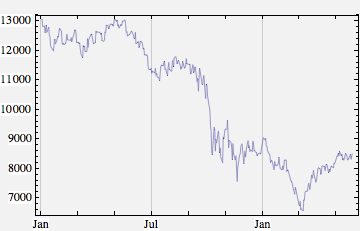
[Financial] Mathematics with Mathematica
Monographic Seminar
Galina Filipuk
Andrzej Kozłowski
General Introduction
The seminar will consist of three parts. The first one, given by Galina Filipuk, will be held from the beginning of October until mid January, and will be devoted to a general study of computer algebra and in particular Mathematica as a tool for doing mathematics. Thus it will involve both the study of the Mathematica programming language, particularly the use of functional and pattern-based programming (which is unlike that in most familiar procedural languages such as Java or C), as well as various mathematical examples in which computers cna be used effectively. Particular attention will be paid to mathematical and programming techniques which will be useful in the second part of the course devoted to financial mathematics. However, the first part of the seminar will be largely independent of the second and, in particular, will not require any knowledge of finance. The second part of the seminar, which will be held during the period mid January- beginning of April and given by Andrzej Kozlowski, will concentrate on applying Mathematica to modeling financial derivatives. Finally, the thirs and last part of the course, roughly from the beginning of April till the end of the Summer term, will conducted over the Internet and consist mainly of the students solving assigned homework problems based on the second part.
Internet
The Internet will be an essential tool in this seminar. All seminar participants should join a mailing list on which various aspects of the seminar will be discussed, questions posted and answered, etc. The list will be particularly important during the last stage of the course.
Part I: Introduction to computer aided mathematics with Mathematica.
A detailed description of this part of the seminar will appear later.
Part II: Modeling of financial instruments with Mathematica
This seminar has been running since 2003 and until last year it was based on the book Modelling Financial Derivatives with Mathematica (1999 Cambridge University Press ) by William Shaw. The book and the seminar were concerned almost completely with only one aspect of modeling: computing the values of options and other derivative instruments by symbolic or numerical means in the Black-Scholes model. A lot of changes have taken place recently that have influenced changes in the contents of the course. On the one hand, the financial crisis of 2008 has further undermined the faith on the sufficiency of the Black-Scholes model as a practical modeling tool. The Black-Scholes model assumes that stock prices move continuously and that stock returns are normally distributed, but a glance at the Dow Jones stock prices for 2008 clearly shows dramatic jumps that are extremely unlikely under this model.


Models with "jumps" have long been studied by academics but tended to be avoided by practitioners because discontinuous jumps cannot be hedged and the historical stock prices do not determine unique option prices which do not admit arbitrage. Nevertheless recent experience has shown that jump based models can no longer be ignored. One purpose of the seminar is to introduce one type of jump models based on exponential Lévy processes, of which the classic Black-Scholes model is a special case. Studying such models with Mathematica has become much easier thanks to several new features that appeared in Mathematica's version 6. The main one are the new abilities to easily create interactive programs. What is more, such programs do not need Mathematica to run but can be used with the free Mathematica Player or the more powerful (but not free) Mathematica Player Pro. This makes it possible to use Mathematica for development of professional tools in financial mathematics (and other areas) that can be used by professionals with no knowledge of Mathematica. The new interactive abilities of Mathematica make it an excellent tool for creating, analyzing and explaining financial models. Wolfram Research has created a site where live "demonstrations" made with Mathematica 6 or later can be uploaded and submitted for publications by anyone with access to Mathematica and an Internet connection. These submissions are then refereed and if accepted become available for download, both in the "live" (interactive) form, which can be used with the free Mathematica Player and in the form of Mathematica notebooks containing the source code. Studying the source code is an excellent way to learn Mathematica and the code can be reused in new demonstrations or in independent applications.
The Wolfram demonstration site contains demonstrations on many subjects, including Finance. The site has itself become the subject of an article published in the Journal of Economic Education. Studying and modifying existing demonstrations is an excellent way to learn computational finance and Mathematica at the same time. The purpose of the course will be to learn enough Mathematica and option pricing to enable students to create independent demonstrations that can be published on the Demonstrations site.
![]() Created with Wolfram Mathematica 7.0
Created with Wolfram Mathematica 7.0